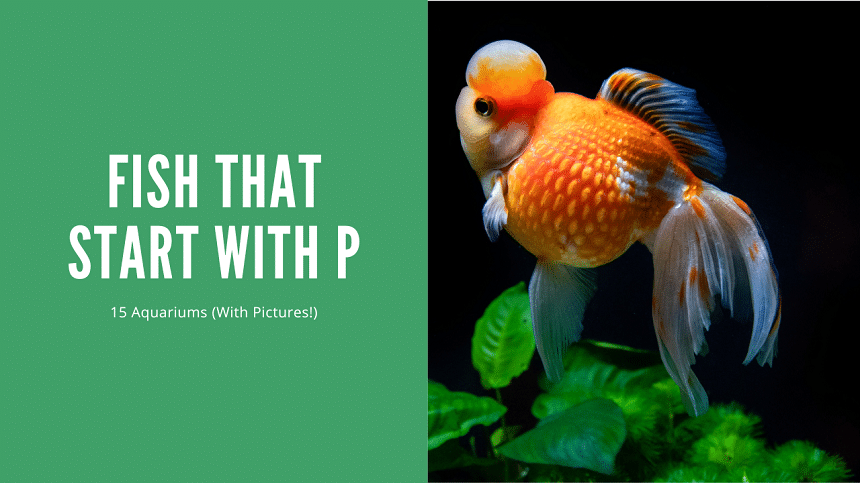Thank you for visiting! By the way… any links on this page that lead to products on Amazon and other stores/partners are affiliate links Aquarium Store Depot earns a commission if you make a purchase.
Not sure which fish to get next? Try going through the alphabet and looking at every fish that starts with each letter. Eventually, you’ll end up at the letter P.
P is a great letter for tropical fish! Many of the most colorful yet hardiest species start with P, so you might not make it to Q too fast–which trust us, doesn’t provide nearly as many options. Here are some of the best fish that start with the letter P as well as some of the less common species available.
Key Takeaways
- There are many fish whose name begins with the letter P.
- Some of the most recognized P-lettered fish are pufferfish, piranha, platies, and pipefish.
- Unfortunately, not even fish that begins with P can be kept in the aquarium, due to size, aggression, or other behaviors.
- If you’re stuck deciding which fish to get next, the letter P offers many options to choose from!
15 Fish That Start With P
Here is a full list of popular aquarium fish that start with P along with a few other species you may have never heard of or considered for your own freshwater or saltwater aquarium.
1. Platies
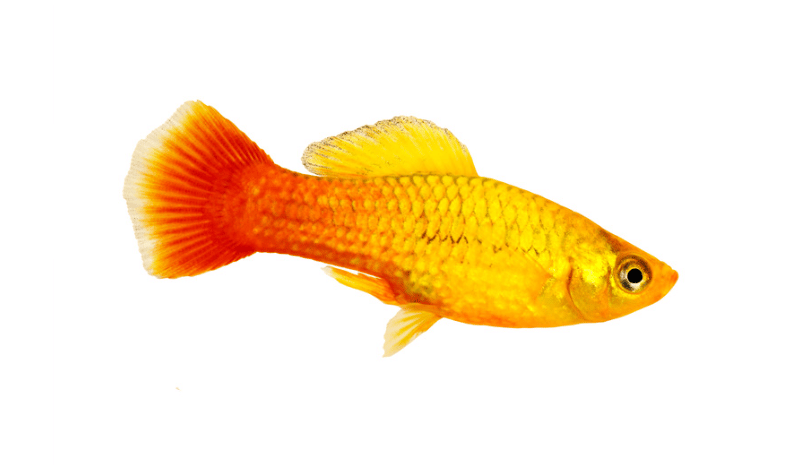
- Scientific Name: Xiphophorus maculatus
- Fish Family: Poeciliidae
- Water Type: Freshwater
- Temperament: Peaceful
- Care Level: Easy
- Size Range: 2-3 inches
- Special Features: Different varieties and colors
Platy fish are one of the most common freshwater fish to come across in the aquarium hobby. These fish are relatively small yet packed with color. There are many varieties of platy available, with long or short fins along with nearly every color and pattern imaginable.
Here are some of the most popular varieties of platyfish available:
- Red wagtail platy – Red with black fins
- Sunset platy – Gradients of reds, yellows, and oranges
- Panda platy – Half black and white with black spots
- Hi-fin platy – Extended dorsal fins
Platies are some of the easiest fish to care for that start with P. They need a 10 gallon tank and tropical conditions but will adapt to appropriate tank and water conditions. Some hobbyists find these fish a nuisance due to their prolific live birth rates.
2. Pearl Gourami

- Scientific Name: Trichopodus leerii
- Fish Family: Osphronemidae
- Water Type: Freshwater
- Temperament: Peaceful
- Care Level: Moderate
- Size Range: 4-5 inches
- Special Features: Irridescent spots
The pearl gourami is an understated species of fish that fits perfectly into planted community tanks. These fish are medium-sized with shiny bluish-white spots all over their body. Like other gouramis, they have long sensors that reach out in front of them to help navigate their surroundings and find food.
Pearl gouramis are moderately easy to keep. They are slightly larger than most freshwater fish and need a 30 or 40 gallon aquarium. While active swimmers, pearl gouramis need plenty of space to hide and tank mates that match their calm demeanor.
3. Paradise Fish

- Scientific Name: Macropodus opercularis
- Fish Family: Osphronemidae
- Water Type: Freshwater
- Temperament: Generally peaceful
- Care Level: Easy
- Size Range: 2-3 inches
- Special Features: Bright colors
Once a very popular freshwater fish, paradise fish can still bring immense color to the aquarium. These orange and blue fish are a generally peaceful species that does well in planted aquariums. These are some considerations needed when planning tank mates as these fish can be aggressive to similar-looking species.
While forked tail paradise fish, Macropodus opercularis, is the most common type of paradise fish to come across, there are a few other species that you might find:
- Macropodus chinensis – Round tail
- Macropodus cupanus – Pointed tail
Like other types of gourami, paradise fish are easy to keep. They require a 20 gallon aquarium with tropical water conditions.
4. Painted Talking Catfish
- Scientific Name: Acanthodoras cataphractus
- Fish Family: Doradidae
- Water Type: Freshwater
- Temperament: Semi-aggressive
- Care Level: Moderate
- Size Range: 2-4 inches
- Special Features: Nocturnal
Also known as the spiny or chocolate catfish, the painted talking catfish (video source) isn’t commonly seen in the aquarium hobby. These striped fish may be confused with the striped Raphael catfish (Platydoras armatulus) but stay slightly smaller.
These talking fish are named after their ability to produce sound. Like other catfish, they have long barbels and nocturnal behaviors. They are mainly detritivores but might try to eat small fish. The minimum tank size recommended is 40 gallons.
5. Praecox Rainbowfish
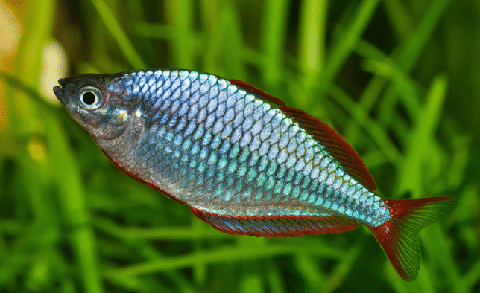
- Scientific Name: Melanotaenia praecox
- Fish Family: Melanotaeniidae
- Water Type: Freshwater
- Temperament: Peaceful but active
- Care Level: Easy
- Size Range: 2-3 inches
- Special Features: Bright iridescent coloration
Most species of rainbowfish grow to moderate sizes, but the praecox rainbowfish, also known as the dwarf neon rainbowfish, stays a manageable size. Due to their small potential size, praecox rainbows only require a 20 gallon school but need to be kept in schools.
Praecox rainbowfish (also known by their common name dwarf rainbowfish) are very active fish and need a long aquarium setup. Tank mates should also match their active behavior so that they are not stressed or out-competed during feeding times.
6. Plecostomus
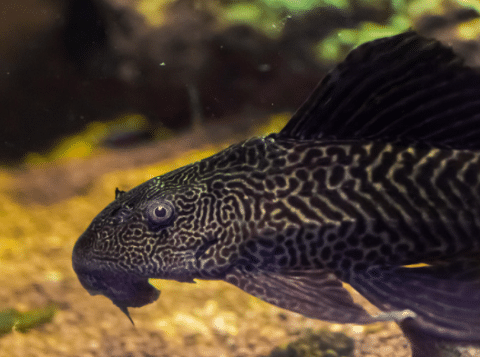
- Scientific Name: Hypostomus plecostomus
- Fish Family: Loricariidae
- Water Type: Freshwater
- Temperament: Semi-aggressive
- Care Level: Moderate
- Size Range: 12-15 inches
- Special Features: Large suckermouth
The common plecostomus is probably the first fish that comes to mind that starts with the letter P. These freshwater fish have been in the aquarium hobby for a long time and carry a lot of discussion around them. These a large fish that need a lot of space, but they’re often sold as beginner-friendly at only a couple of inches long.
In reality, common plecos need well over a 100 gallon aquarium for long-term housing. Not only are these fish big, but they also live up to 15 years. Ideally, common plecos should only be kept in a pond or lake setting; if keeping your pleco outdoors, make sure that the area is contained as common plecos are becoming an increasingly invasive species.
7. Pigeon Blood Discus
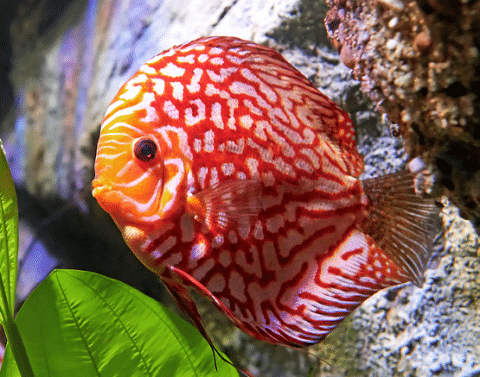
- Scientific Name: Symphysodon spp.
- Fish Family: Cichlidae
- Water Type: Freshwater
- Temperament: Peaceful
- Care Level: Moderate to expert
- Size Range: 8-12 inches
- Special Features: Bright red and bluish-white coloration
The pigeon blood discus is a specific variety of discus fish. These freshwater fish are recognized by their unmistakable plate-like bodies with bright red and bluish-white dappling.
Discus fish are one of the more difficult species of fish to take care of in the aquarium setting. They require warmer water temperatures between 82° and 86° F and large tanks above 75 gallons. They are not hardy and hobbyists often find that their discus tanks need daily water changes to thrive. That being said, many discus keepers also successfully keep these fish with minimal maintenance.
8. Pygmy Corydoras
A smaller variety of Cory Catfish. Grows to less than 1.5 inches in length. A peaceful bottom dwelling fish
- Scientific Name: Corydoras pygmaeus
- Fish Family: Callichthyidae
- Water Type: Freshwater
- Temperament: Peaceful
- Care Level: Moderate
- Size Range: <1 inch
- Special Features: Small size
The smallest, and arguably cutest, species on this list, the pygmy corydoras is a great tank mate for most community planted tanks. Pygmy corys stay very small but require a school of at least 6 or more. Even then, a moderate-sized school of them can comfortably live in a 10 gallon aquarium.
Though easy to keep, these corydoras can be extra sensitive to stress and improper water parameters. This is one fish that especially benefits from being quarantined before being added to the main display tank.
9. Pearlscale Goldfish
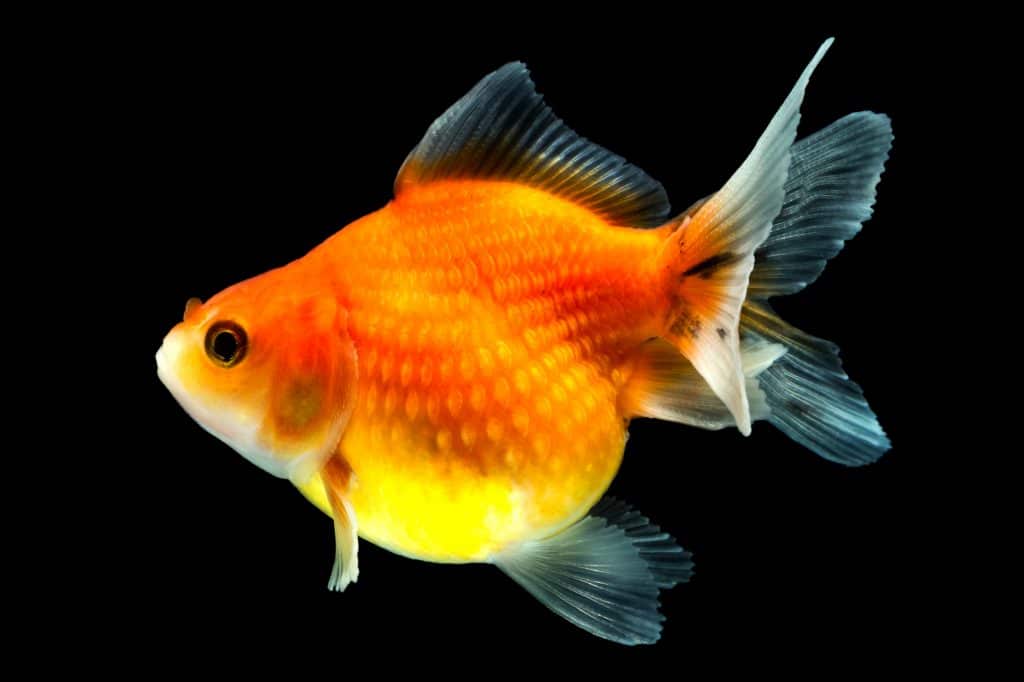
- Scientific Name: Carassius auratus
- Fish Family: Cyprinidae
- Water Type: Freshwater
- Temperament: Peaceful but active
- Care Level: Easy to moderate
- Size Range: 6-8 inches
- Special Features: Scaly, bumpy body
The pearlscale goldfish is not sick with dropsy! Instead, this breed of goldfish has been carefully bred to display a rough, bumpy texture on its body and an extra egg-shaped body.
Most goldfish breeds are easy to care for as long as you have the appropriate space and filtration. Pearlscale goldfish need at least 20 gallons, with bigger always being better. As goldfish, they need powerful filtration and regular tank maintenance.
However, unlike other goldfish breeds, pearlscales won’t excel in outdoor ponds. These fish have delicate scales that need to be protected from bumping into both dull and sharp objects.
10. Peters Elephantnose Fish

- Scientific Name: Gnathonemus petersii
- Fish Family: Mormyridae
- Water Type: Freshwater
- Temperament: Peaceful but can be territorial
- Care Level: Difficult
- Size Range: 7-9 inches
- Special Features: Long nose and unusual body shape
Peters elephantnose fish, simply known as the elephantnose fish, is one of the most interesting-looking fish on this list! These tropical fish originate from Africa and feature a unique feature called the Schnauzenorgan. This extended nose helps them locate food, navigate their surroundings, and communicate with other fish through electroreceptors; interestingly, the rest of their body is also covered in these receptors.
The Peters elephantnose fish is a large, active fish that can possibly pose a threat to other smaller fish in the aquarium. They need at least a 55 gallon tank, but a 100 or more gallon aquarium will allow them to show their most natural behaviors.
11. Polka Dot Loach
- Scientific Name: Botia kubotai
- Fish Family: Botiidae
- Water Type: Freshwater
- Temperament: Peaceful
- Care Level: Moderate
- Size Range: 5-6 inches
- Special Features: Outgoing personality
The polka dot loach (video source), also known as the angelicus loach, is an attractive fish with a big personality. They have a similar appearance to other freshwater loaches, like the yoyo loach (Botia almorhae), but have more segmented natural patterns as adults.
Polka dot loaches do best when kept in groups of at least 6 or more. This means that they need an aquarium size of at least 55 gallons or more. These are very active bottom-dwellers that will search the substrate for plant matter and leftover food but will not eat fish waste or other decaying organics.
12. Pufferfish (Freshwater)

- Fish Family: Tetraodontidae
- Water Type: Freshwater, brackish
- Temperament: Semi-aggressive to aggressive
- Care Level: Moderate
- Size Range: 1-24 inches
- Special Features: Hard beak, inflatable
Some of the most recognizable fish that start with P belong to the freshwater pufferfish group. Many species of freshwater puffer can successfully live in the aquarium setting, including:
- Pea puffer (Carinotetraodon travancoricus)
- Fahaka puffer (Tetraodon lineatus)
- Figure-8 puffer (Tetraodon biocellatus)
- Congo puffer (Tetraodon miurus)
These fish range from very small to very large and recommended tank size will vary. Most of these species are incompatible with other fish, though might enjoy the company of each other.
It should be noted that some of these species may need to be kept in brackish water conditions as they mature.
13. Pufferfish (Marine)
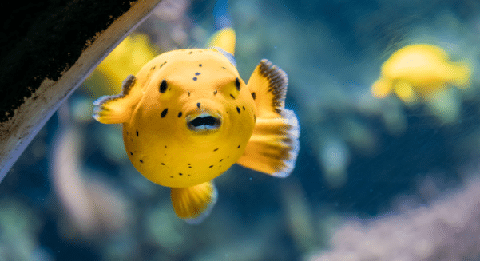
- Fish Family: Tetraodontidae
- Water Type: Saltwater
- Temperament: Semi-aggressive to aggressive
- Care Level: Moderate
- Size Range: 4+ inches
- Special Features: Hard beak, inflatable
Possibly even more popular aquarium fish than their freshwater cousins, saltwater pufferfish are big and bold. This means that most species of this saltwater fish need at least a 75 gallon tank or more, though it is much easier to pair them with other aggressive tank mates.
Some of the most popular saltwater pufferfish are:
- Dogface puffer (Arothron nigropunctatus)
- Porcupine puffer (Diodon holocanthus)
- Stars and stripes puffer (Arothron hispidus)
- Saddle puffer (Canthigaster coronata)
Again, the exact needs for each of these fish will vary by species. However, these are totally saltwater fish that need appropriate salinity levels throughout their lifetimes.
14. Pipefish

- Fish Family: Syngnathidae
- Water Type: Saltwater
- Temperament: Peaceful
- Care Level: Difficult
- Size Range: 3-15 inches
- Special Features: Long body and pointed snout
Closely related to seahorses, pipefish are known for their snake-like, elongated body. These are very interesting-looking fish that look great in an aquarium but are difficult to provide proper care for.
Unfortunately, pipefish need very specific saltwater aquarium setups with gentle water flow, suitable water parameters, and a careful diet. These fish don’t transition to aquarium life well and it can be a challenge to ensure that your fish eats and gets enough to eat.
There are a few species of pipefish available for purchase in the aquarium hobby:
- Banded pipefish (Doryrhamphus dactylophorus)
- Bluestripe pipefish (Doryrhamphus excisus)
- Yellow multibanded pipefish (Doryrhamphus pessuliferus)
15. Painted Glass Fish

To round off this list, we need to talk about painted glass fish. Unfortunately, this cruel type of fish also starts with P. Product Review Help has a great video example of the inhumane above. 80% of these fish will die in the process of the injection!
Painted glass fish are artificially dyed glass fish (Parambassis ranga), that have been injected with various colors and chemicals. These are regularly confused with GloFish, which gain their bright neon colors through genetics. The painted glass fish industry should not be supported. GloFish are a much more humane and safe practice for achieving the same effect.
There are different species of GloFish available:
- Zebrafish (Danio rerio)
- Black skirt tetras(Gymnocorymbus ternetzi)
- Tiger barbs(Puntius tetrazona)
- Rainbow sharks (Epalzeorhynchos frenatum)
- Betta fish (Betta splendens)
There are no special care requirements for GloFish. Instead, the basic needs of the given species will need to be met.
Other Species That Can’t Be Kept In Aquariums
As you can imagine, there are many fish that start with the letter P that can’t be kept in the aquarium. This could be due to a lack of demand, space requirements, dietary needs, or aggression.
Here are some species that didn’t make the cut!
- Pacific Lamprey (Entosphenus tridentatus). We think it’s fair to say that nobody would want to keep a Pacific lamprey in their home aquarium. While one of the most ancient fish in aquatic ecosystems, lampreys are eel-like fish with serrated mouths and sharp teeth they use to stick onto and digest prey. These P-lettered fish are impractical to keep in the aquarium due to their size and activity.
- Pacific Salmon (Oncorhynchus spp.). The term Pacific salmon often refers to sockeye, king (chinook), coho, chum, and pink salmon. These are very important food fish for commercial fishing that undergo a massive migration to the northern Pacific Ocean. This migration is necessary for their life stages and would not be possible in an aquarium setting.
- Pacific Hake (Merluccius productus). Also known as Pacific whiting or Jack salmon, Pacific hake are large deep-sea fish in the eastern Pacific Ocean. This fish species undergoes daily vertical migration, sometimes moving over 1,000 feet a day, which is impossible to recreate in an aquarium setting. The Pacific hake is also an important commercial species.
- Pilot Fish (Naucrates ductor). These fish are rarely seen without a nearby shark or turtle. Pilot fish grow to big sizes and travel long distances. They rely on other fish, mainly elasmobranchs, to catch leftover food and clean up parasites.
- Port Jackson Shark (Heterodontus portusjacksoni). Native to southern Australia, the Port Jackson shark is a type of bullhead shark that grows to be nearly 6 feet long. They are a nocturnal species that relies on migrating around the continent for reproduction.
- Pacific Fat Sleeper Goby (Dormitator latifrons). Found in freshwater, saltwater, and brackish conditions, the Pacific fat sleeper goby is native to portions of North and South America. These fish live in between tides in estuaries and inlets and have developed a special method of breathing called facultative air-breathing. They have a specialized diet of mud and other organic material, which would be difficult to supply in a home setting.
- Pelagic Cod (Melanonus gracilis). The pelagic cod is a deepwater fish that lives in cold to temperate water conditions. These fish have no commercial value and should not be confused with Atlantic or Pacific cod.
Honorable Mentions
Here are other fish we ran out of space to post in this blog post:
- Blood Parrot Cichlid
- Pearl Roach
- Pike Conger
- Peacock Cichlid
- Panda Dwarf Cichlid
- Panda Corydoras
- Parrot Fish
- Peacock Flounder
- Pelican Eel
- Pacific Herring
- Pacu (Invasive – has been caught in Lake Michigan) but to not keep in aquariums
Other Lists
Looking for other fish that start with other letters of the alphabet? Check out the other posts below:
FAQs
What is a flat fish that starts with P?
The flattest fish that starts with the letter P are plaice (Pleuronectidae), more commonly recognized as flounders. There are four main types of plaice: American, Alaskan, European, and scale-eye plaice.
What is the Florida fish that starts with P?
There are many species of fish in Florida that start with P. Some of these fish might include pinfish (Lagodon rhomboides), Pompano dolphinfish (Coryphaena equiselis), and porkfish (Anisotremus virginicus).
What predatory fish starts with P?
The most well-known predatory fish that starts with P is the piranha (Serrasalmidae family). Though these carnivorous fish might look fearsome, there is a lot of misunderstanding behind them. One thing to note is that they make great aquarium fish, though!
What fish starts with the letter P?
With over 33,000 different species of fish, many fish names start with the letter P! If you can’t decide what kind of fish you want to add to your aquarium, pick a letter and see which options fit best for you.
Conclusion
There are many fish that start with the letter P. Some big, some small, some saltwater, and some freshwater, with a species that’s appropriate for any fish tank setup. As with any species, make sure that you can provide a life-long home for whichever P-named fish you decide to get!
- About the Author
- Latest Posts
I’m thrilled that you found Aquarium Store Depot! Here you’ll find information on fish, aquariums, and all things aquatics related. I’m a hobbyist (being doing this since I was 11) and here to help other hobbyists thrive with their aquariums! I adhere to a high quality Editorial Process and Review products with real life field usage and practical analysis.

